Fertilization management can be considered both a science of what plants require and an art of how nutrients are supplied. The major nutrients taken up by plants are nitrogen (N), phosphorus (P), and potassium (K). With these three elements being the heavy lifters, most fertilizer programs focus on delivering NPK to the plant. The other elements included in fertilizers are still essential but generally are provided at constant levels. We evaluated two commercial cannabis fertilizer programs developed by suppliers who were willing to share their recipes and compared each program to our cannabis fertility research program at North Carolina State University (NCSU).
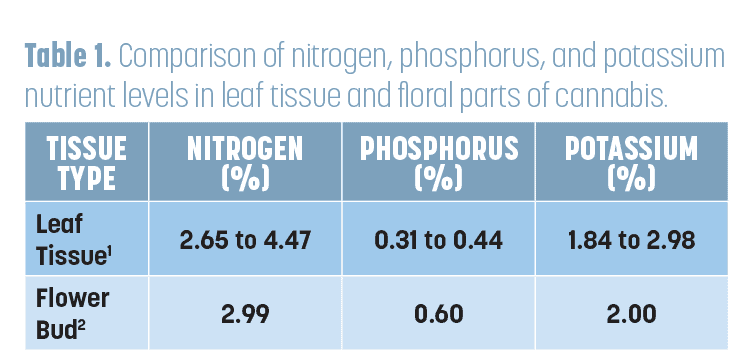
Nitrogen (N)
Nitrogen is one of the most important elements for plants as it influences overall plant growth. If provided in insufficient levels, plant growth is stalled. If N levels remain too low, plants will be stunted. The other obvious visual symptom is lower leaf yellowing (chlorosis) (Fig. 1, above). In greenhouse or indoor cannabis production, the typical substrates used hold limited amounts of nutrients. Therefore, if N levels are too low, noticeable symptoms will readily occur on plants in just two or three weeks. Adversely, excessive N levels can lead to lush leaf growth at the expense of flower development.
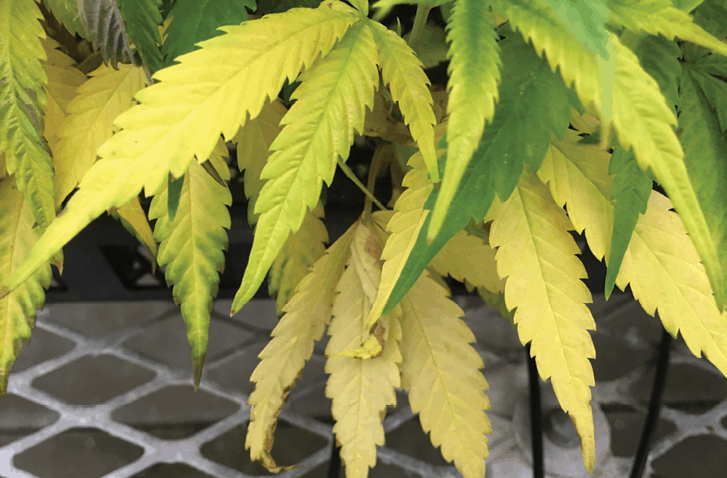
Photo by Brian Whipker
Evaluation. When evaluating fertility programs recommended by two fertilizer suppliers, both Suppliers A and B offer similar scheduled feeding recommendations (Fig. 2A and 2B, below). Both suggest a lower amount of N during the plant establishment stage. Small, newly transplanted plants are primarily developing root systems and will not allocate energy into shoot growth until the roots reach the outside of the pot, which will occur during two to three weeks of growth.
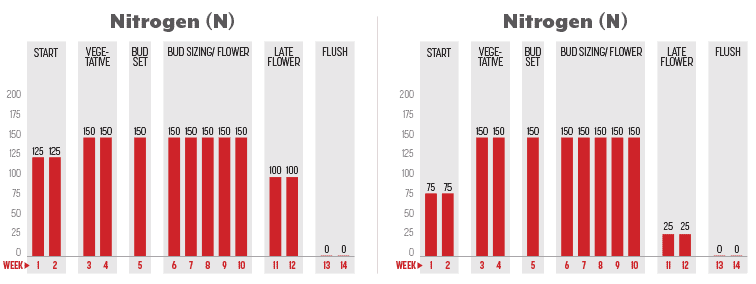
While the cannabis plants are bulking up, both fertility programs recommend 150 parts per million (ppm) N. In our studies at NCSU, we also use between 150 and 200 ppm N at this stage of development (up to about week 10 of growth), and plant growth is robust.
Both fertility regimens remain the same until the late flower stage (after about week 10 of production), when N levels are reduced to between 25 and 100 ppm N. Both companies then curtail all fertilizer applications during the last two weeks of production. Decreasing and then ceasing fertilization allows plants to uptake any nutrients contained in the substrate. Also, if the plant requires additional N, the plant will translocate (move) it from the older leaves to the younger leaves if needed, as N is a mobile element.
Nitrogen uptake patterns by cannabis indicate that most nutrients are acquired during the first half of the growing season and then are translocated, if needed (Fig. 3). A comparison of N levels in leaf tissue with N levels in floral buds found that both were similar in concentration (Table 1). This suggests that providing excess levels of N late in the production cycle will stimulate additional leaf growth, which can lead to lower quality flower buds.
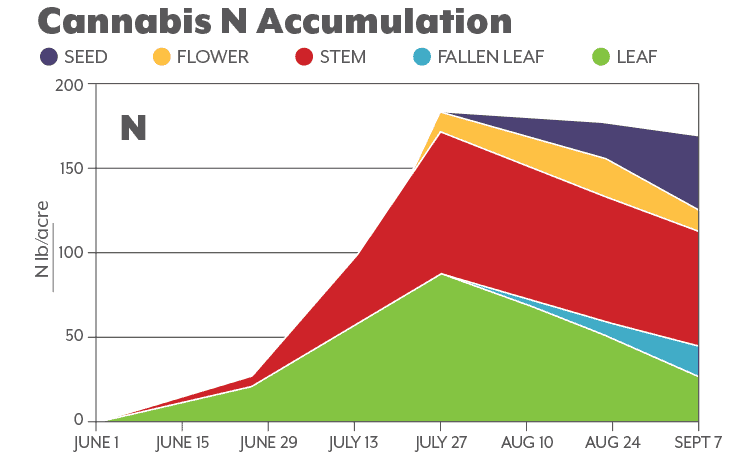
Phosphorus (P)
Another major element that affects overall plant growth is P. Its major contribution is stem elongation, contributing to more branching and creating a fuller plant architecture and canopy. When P is limited, plants do not have an extensive branching canopy and exhibit stunted plant growth, resulting in less floral material.
When P is limited, leaf symptomatology may manifest in two different ways, the traditional presentation being lower leaf purpling. This occurs in many other species, especially when the plants are grown under cool and wet conditions, but it’s usually not found in cannabis grown in optimal greenhouse or indoor conditions. Overall purpling has been observed during late flower bud development, and may be attributed to either genetic cultivar differences or if P nutrient stress is occurring (Fig. 4).
The second symptomatology is slight plant stunting, which is followed by olive-green spots developing in an irregular pattern along the leaflets on the lower and older leaves (Fig. 5, at right). As symptoms progress, the spots grow larger and appear sunken and almost wet with some marginal necrosis (death). Over time, chlorotic leaves become severely olive spotted with large areas showing symptoms. Leaf drop occurs with advanced symptomatology.
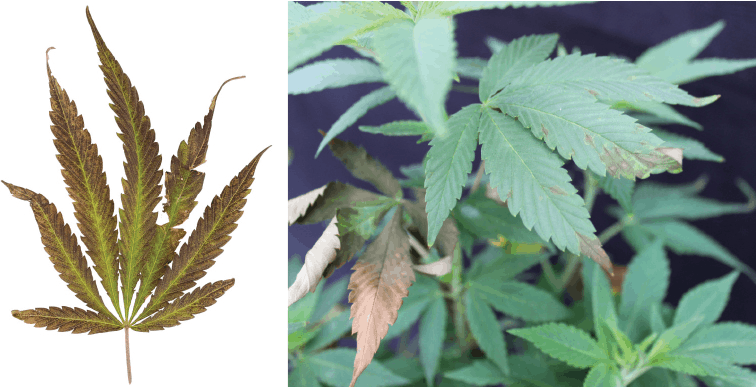
Left photo by Brian Whipker; Right photo by Paul Cockson
Research conducted by Dr. Josh Henry during his master’s program at NCSU focused on optimizing P fertilization rates for ornamental and vegetable plants. In most cases, the optimal range was between 10 and 15 ppm P. Rates from 5 to 10 ppm resulted in more compact plants, while rates below 5 ppm P severely stunted plant growth and limited the overall plant quality.
Phosphorus is a major component of floral and especially the fruiting (seed) portions of the plant, meaning plants require a higher amount of P to meet those demands. Research tracking cannabis nutrient uptake with a seed crop in Manitoba, Canada (Fig. 6, below), identified very early accumulation of P into the plant leaves and stems. Near maturity, P, a mobile element, was translocated by the plant into the floral parts to meet the increased P demand of the developing seeds. This suggests that higher rates of P applied early in the growth cycle would be beneficial to cannabis. Late in the production cycle, plants require and take up limited amounts of P to meet the basic needs of maximizing plant growth and floral yield. This does not mean plants will not absorb the oversupply; but additional uptake is referred to as “luxury consumption,” when tested leaf tissue values reflect those higher levels of P, but those higher levels provide limited, if any, additional benefit.
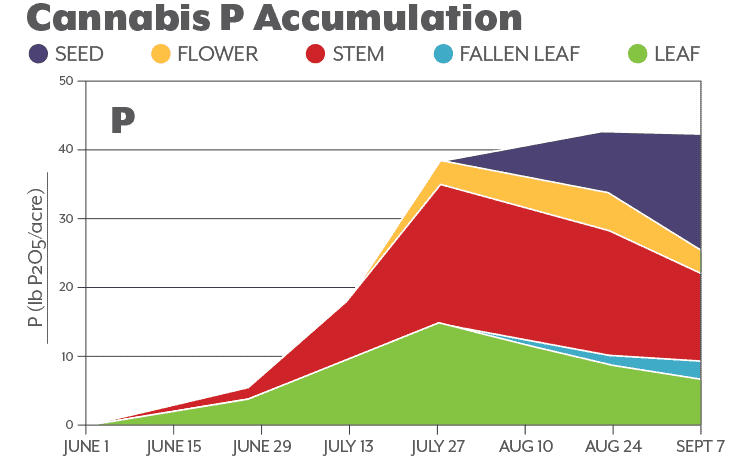
Evaluation. Supplier A’s fertilizer program starts with lower levels of P (22 to 52 ppm) and then increases to 196 ppm P at bud set (Fig. 7A), providing lower levels when the plant’s root system is still developing and cannot take up a large quantity of nutrients. The one-week boost of 196 ppm P would load up the system and should ensure that an adequate supply of P is available to the plant for later translocation as the flower bud matures.
Fertilizer Supplier B’s program (Fig. 7B) provides a much higher level of 65 ppm P at the start to aid in root development, then decreases for two weeks to 43 ppm P during vegetative growth. Levels then increase for one week during bud set to 130 ppm P. During the five weeks of bud sizing, flowering is maintained at 196 ppm P, before decreasing toward maturity.
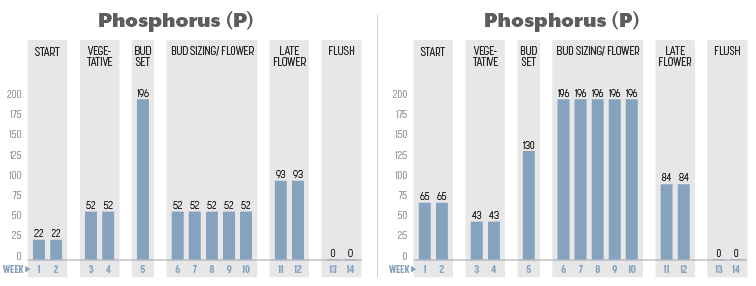
A pre-charge of P boost during bud set makes sense to build up a reserve in the plant at a time when the root system should be able to utilize (uptake) the fertilizer delivered. Based on the nutrient uptake patterns from the Manitoba, Canada research, the continual high level during bud sizing and flowering does not seem necessary. A lower level as suggested by Supplier A seems more appropriate. A comparison of leaf tissue P levels with floral bud P levels found that floral material had a higher level (Table 1). This would support making sure that adequate levels are provided, but it does not suggest that P fertilization at excessively high levels (>100 ppm P) is warranted.
To take this one step further, recent unpublished research led by Paul Cockson at NCSU found that a continuous program of approximately 15 ppm P was optimal when considering plant growth, flower bud yield, and cannabinoid concentrations. Lower P levels resulted in smaller plants with lower yields. Higher P levels of up to 30 ppm P did result in larger plants and flower bud yield, but those flower buds had a lower cannabinoid concentration (most likely due to a dilution effect). We took the typical commercial floriculture approach to fertilization of making it simple by providing a continuous supply of P.
In our research studies at NCSU, we target about 20 ppm P as a continuous fertilization during the entire production cycle. No doubt further research will help determine if varying the rate at key points in the production cycle and providing P at levels of 30 to 196 ppm may prove beneficial. But at this time, based on our research, providing excessively high P levels above 30 ppm does not appear to be a beneficial nor cost-effective fertilization strategy.
Potassium (K)
Potassium contributes to strong stems, energy production in photosynthesis, and is required in the stomates for regulating transpiration. K deficiencies initially result in leaf-margin yellowing, especially the saw tooth of the leaflets, on the lower and older foliage (Fig. 8, below). As symptoms progress, the marginal yellowing will become more pronounced and intensify on older leaves, expanding inward toward the midrib. As symptoms advance, leaflet margins will yellow, and some regions of tan necrosis will develop, especially along the leaflets’ saw tooth margin.
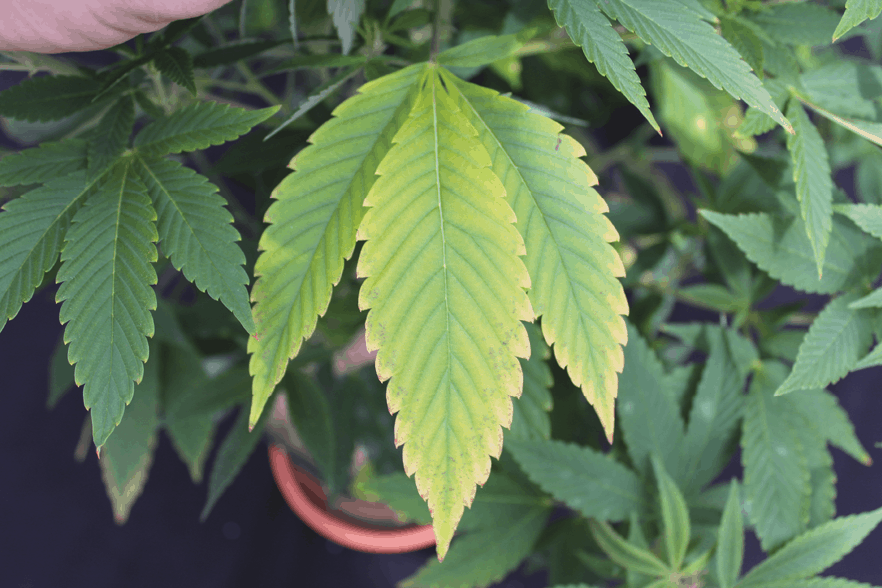
Photo by Paul Cockson
Evaluation. With our research studies at NCSU, we target 160 to 200 ppm K as a continuous fertilization during the entire production cycle. While we have not conducted any K rate experiments to determine optimal rates or if they need to change over time, our plants are robust and healthy. Supplier A’s plan start low during plant establishment then maintains a fairly constant rate of 217 ppm K, with one week at 250 ppm K during bud set (Fig. 9A). During the last two weeks of late bud set, K is increased to 357 ppm K. Research with other species has identified a critical window of K demand during flowering and fruit (seed) development. This fertilization program is addressing that possibility. Further research evaluating this program’s advantages would assist in determining if the cannabis industry should adapt to this production protocol.
Supplier B, for the most part, targets similar K levels (193 to 271 ppm K) during the production cycle (Fig. 9B). This program focuses on a preload of K at 271 ppm during the vegetative stage. One notable difference is that Supplier B recommends reducing K to 125 ppm during bud set, while Supplier A increases it to 250 ppm. Supplier B suggests 193 ppm K for late flowering, in contrast to Supplier A’s target of 357 ppm K.
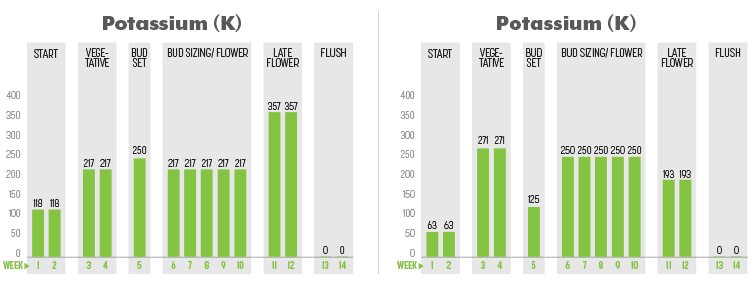
The seed hemp crop K uptake patterns reported by the Manitoba, Canada, researchers also indicate the majority of K accumulation occurs during the first half of the plant production cycle (Fig. 10). This would suggest that the 200 to 300 ppm K provided by both fertilizer programs would be utilized by cannabis plants, especially during the initial growth. A comparison of K levels in leaf tissue and floral bud found similar concentrations in both (Table 1). The pronounced late-season increase of K should be investigated to determine how it benefits overall plant growth.
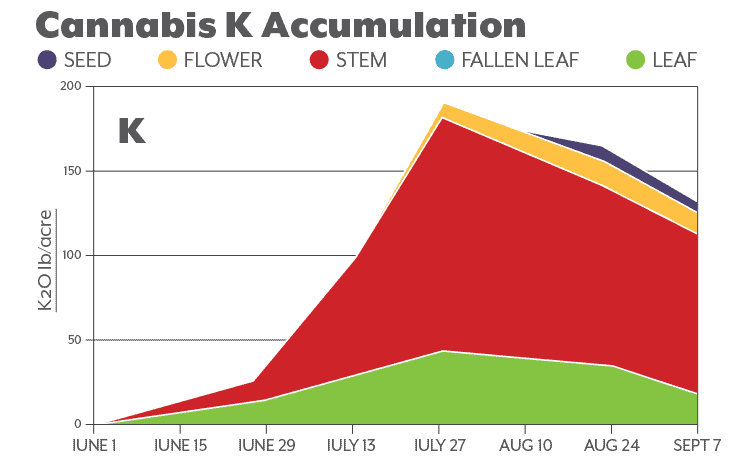
Evaluating Your Fertilization Program
How does your fertilization program compare to what the plant needs over time? The industry uses a wide variation of fertilizer inputs, both with conventional and organic production. The first step is determining the nutritional contribution of each of your fertilizers to calculate how much you are applying. This is especially important when using most organic products, which do not provide that information on the label. Simply mix the nutrient solution at the recommended levels then submit that fertilizer sample to a commercial lab for nutrient analysis. From there, you can evaluate if adequate levels are being delivered.
Cultivators can also evaluate supplemental products to determine, with data, if they are beneficial to plants. Simply stating that it looks like growth is improved with the addition of Product X is not adequate; quantitative comparison data is needed to compare whether including the product or excluding it (with adjustments made to equal out any nutrient contribution of both products being evaluated) is beneficial. If the only primary effect is that it provides more N, P or K to the plant, it may be more economical to just supply additional fertilizer salts to your program instead of adding a more expensive supplement.
By taking these steps and putting your fertilizer program to the test, you can determine if it provides sufficient nutrients your plants need.
Dr. Brian E. Whipker is a professor of floriculture at North Carolina State University specializing in plant nutrition, plant growth regulators and diagnostics. During the past two years, he co-authored eight scientific journal articles on the impact of fertilization with greenhouse species and three disorder diagnostic guides. Dr. Whipker has more than 28 years of greenhouse experience working with growers.
Paul Cockson is a graduate research and teaching assistant at North Carolina State University. He has a degree in plant and soil sciences with a concentration in agroecology. For the past few years, he has worked in the plant nutrition lab at NCSU with Dr. Brian Whipker.
Patrick Veazie is an undergraduate researcher at North Carolina State University.
David Logan is an undergraduate research assistant at North Carolina State University.
Dr. W. Garrett Owen is an assistant professor and extension specialist of floriculture, greenhouse, and controlled-environment crop production in the Department of Horticulture at the University of Kentucky.